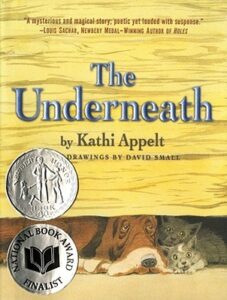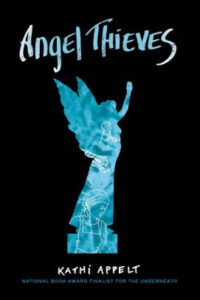The Where of it All: Place and Story, a guest post by Kathi Appelt
 Years ago, when my novel The Underneath came out, one of the reviewers called it “Southern Gothic for the middle-grade set.” At first, I was a little on the crushed side, but the more I’ve thought about it, the more I realized that the reviewer actually got where I was coming from—they understood me as a person who dwelt on the beauty of extended syllables, who cools them down with iced tea from a jar, a person who was raised on William Faulkner and Tennessee Williams. It shouldn’t have come as a big surprise that my voice was a reflection of that. I decided to own it.
Years ago, when my novel The Underneath came out, one of the reviewers called it “Southern Gothic for the middle-grade set.” At first, I was a little on the crushed side, but the more I’ve thought about it, the more I realized that the reviewer actually got where I was coming from—they understood me as a person who dwelt on the beauty of extended syllables, who cools them down with iced tea from a jar, a person who was raised on William Faulkner and Tennessee Williams. It shouldn’t have come as a big surprise that my voice was a reflection of that. I decided to own it.
And now, a little over ten years since the publication of that first novel, I have this new novel, Angel Thieves, that is also deeply ingrained in the place of it. Houston. Fourth largest city in the country, also the most diverse.
ADVERTISEMENT
ADVERTISEMENT
I really believe that the most important three things in our lives all start with the letter P. They are: People. Places. Pets. They’re the “whirled P’s,” as my friend Liz Garton Scanlon calls them. Our deepest loves, our most profound fears are found there. And they’re intertwined, woven together—whirled–in all the ways that generate stories. Try telling a tale without one of those three P’s.
For me, as much as I groove on my People and my six gifted and talented cats, Place is almost always where I begin when it comes to a story. You could say it’s the where of it all.
I don’t have to think for very long when I conjure up Houston. I remember the house where my sisters and I scrawled our names on the interior garage wall, and our big dog Sam watched over a batch of kittens after their mother was hit by a car. (Fyi, Sam was my role model for Ranger). I remember sitting behind a large window and watching the shingles blow off of the house across the street as Hurricane Carla’s winds shook every square inch of the city. I remember the drive-in movie theater called The Thunderbird, where I can still see Doris Day singing “Que Sera, Sera” from the fifty-foot tall screen.
Big, expansive Houston. It’s all sprawled out. And yet, it’s knitted together by those slow-moving bayous that flow right through her heart.
But how did all of the stuff about this particular place play into my work? For one, it made me want to write a tale that was itself expansive, that spanned time periods and crossed borders. Likewise, it made me want to explore the indigenous plants and critters, including the mosquitoes who once spread one episode after another of yellow fever, each time reducing the population by dozens, hundreds.
This central wildness invited me to incorporate wildness into the very middle of my story, and that brought me the ocelot. Like so many other species, they’re no longer extant in Houston. In her own way, because she was once native, she bridges the time spans of this story, from past to now, from dream to real.
To me, place also offers up its unique voices, what some call a sonic landscape. Houston has its own homegrown music. It’s a music mixed up by generations of freed Creoles with their German polka-playing neighbors, making Houston the birthplace of Zydeco. The sounds of an accordion, with its breath being squeezed in and out, the notes pushing and pulling against each other is pure Houston. I love the syncopation of it, the big mixture of joy and sorrow, all forced into those breathy notes. I kept Zydeco in my ear as I wrote, I looked for ways to push and pull the different threads of time and purpose, to squeeze the chapters when called for, to find some moments of joy and urgency and a deep sigh at the end.
There’s so much about Houston that calls to me, even though I haven’t lived there for some time. It feels ripe for Story. Not only that, but I come from seven generations of Houstonians. My roots are deep. I knew Houston. And yet, it wasn’t until I began to write that I felt like I was seeing the city clearly enough to set a story there.
We are always told to “write what you know.” There is a good amount of wisdom in that. But I also want to say, “write because you want to find out.” Years ago, I happened across the paintings of Houston artist John Biggers. One of them stood out to me. I was so struck by it, that I found that I couldn’t step away from it. Maybe I stood there for ten minutes. Maybe it was only ten seconds, but I’ve never forgotten it.
It was a painting set in the Fifth Ward, called “Shotguns,” for the style of houses that stand there, nothing at all like the Fifth Ward I thought I knew, a place considered at the time to be crime-ridden, run-down, the absolute poorest neighborhood in Houston. In this beauty of a painting, suddenly, I saw the Fifth Ward in such a different way. It wasn’t that Mr. Biggers denied the abject poverty. He didn’t. It wasn’t that he was trying to cover something over. He wasn’t. It was that he showed how a place occurs in layers. There was layer upon layer of the Fifth Ward, like looking into a receding wall of mirrors, or the striations of a canyon wall. Before this, I had only seen the surface of the Fifth Ward, an ugly, falling-down place, with trash-strewn yards and boarded up shanties. That was only one layer. And there was the message.
So this is, I think, what Place offers to us in matters of story: multiple layers that only that particular place can hold. For me Houston is a layer of rich black dirt, washing down from the Great Plains and piling up so that the azaleas blaze every March. It’s a layer of fog that streams up from the Gulf of Mexico and hides the skyscrapers, closes the airports. It’s a layer of animals and plants that came and went and might come again if we have enough heart for them. It’s a layer of flood after flood, always bracing for the next flood. Water, layers of water. It’s also a layer of families, including those that settled there long before the Europeans, long before the Mexicans and Texans, long before me. It’s layers of gospel and field songs and blues and Jim Crow and desegregation and Barbara Jordan. It’s layers written in twists and turns, like the Buffalo Bayou herself. Mother River. It’s seven generations of my family, many buried right along that bayou in the old Washington Cemetery.
It’s that Place.
So, I have told my students, and I will tell you, start with Place. Pull back the layers. Stand in the old cemeteries and ask your people to tell you their stories. Ask their neighbors to lend their voices. Ask the trees and the streetlamps and the nighthawks.
Ask that bayou. And then, let it be the where of it all.
Meet Kathi Appelt

Kathi Appelt is the author of the Newbery Honoree, National Book Award finalist, PEN USA Literary Award–winning, and bestselling The Underneath as well as the National Book Award finalist The True Blue Scouts of Sugar Man Swamp, Maybe a Fox (with Alison McGhee), Keeper, and many picture books including Counting Crows. She has two grown children and lives in College Station, Texas, with her husband. Visit her at KathiAppelt.com.
Connect with Kathi online:
Twitter: @kappelt
Facebook: https://www.facebook.com/kathi.appelt.7
Goodreads: https://www.goodreads.com/author/show/29011.Kathi_Appelt
Pinterest board: https://www.pinterest.com/kathi5cats/
Instagram: https://www.instagram.com/kathiappelt/
About Angel Thieves
ADVERTISEMENT
ADVERTISEMENT
 An ocelot. A slave. An angel thief.
An ocelot. A slave. An angel thief.
Multiple perspectives spanning across time are united through themes of freedom, hope, and faith in a most unusual and epic novel from Newbery Honor–winning author and National Book Award finalist Kathi Appelt.
Sixteen-year-old Cade Curtis is an angel thief. After his mother’s family rejected him for being born out of wedlock, he and his dad moved to the apartment above a local antique shop. The only payment the owner Mrs. Walker requests: marble angels, stolen from graveyards, for her to sell for thousands of dollars to collectors. But there’s one angel that would be the last they’d ever need to steal; an angel, carved by a slave, with one hand open and one hand closed. If only Cade could find it…
Zorra, a young ocelot, watches the bayou rush past her yearningly. The poacher who captured and caged her has long since lost her, and Zorra is getting hungrier and thirstier by the day. Trapped, she only has the sounds of the bayou for comfort—but it tells her help will come soon.
Before Zorra, Achsah, a slave, watched the very same bayou with her two young daughters. After the death of her master, Achsah is free, but she’ll be damned if her daughters aren’t freed with her. All they need to do is find the church with an angel with one hand open and one hand closed…
In a masterful feat, National Book Award Honoree Kathi Appelt weaves together stories across time, connected by the bayou, an angel, and the universal desire to be free.
ISBN-13: 9781442421097
Publisher: Atheneum/Caitlyn Dlouhy Books
Publication date: 03/12/2019
Filed under: Guest Post
About Amanda MacGregor
Amanda MacGregor works in an elementary library, loves dogs, and can be found on BlueSky at @amandamacgregor.bsky.social.
ADVERTISEMENT
ADVERTISEMENT
SLJ Blog Network
Name That LEGO Book Cover! (#63)
“If you like my storytelling, this is your jam.” Jason Reynolds Goes All Audio with “Soundtrack”
Band Nerd | Revieew
When Book Bans are a Form of Discrimination, What is the Path to Justice?
Pably Cartaya visits The Yarn
ADVERTISEMENT








Wonderful piece on place. Also just finished listening to MAYBE A FOX. Fantastic! Thanks.
i’m glad you owned it, because I love THAT VOICE. Thanks for the reminder that place is its own character, one that has a stronger influence than many realize.